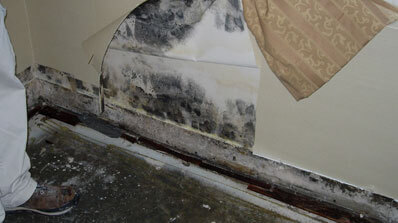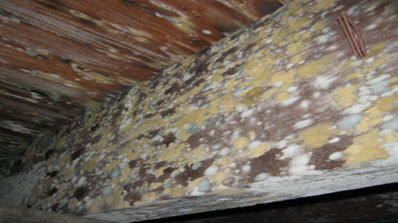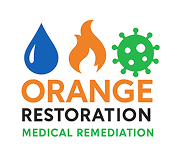A Hard Look at Secondary Mold
We get a number of callers who have the same type of questions and concerns:
- “Why does mold keep coming back?”
- “Is it normal for mold to return after remediation?”
- “Should I redo mold remediation?”
- “How do I know if mold remediation failed?”

..but unfortunately, the answer is always the same. It’s painful to hear these, not just because of the damage, but because we already know what happened.
In Most Cases, This Mold problem Should Have Been Gone for Good…
But here’s the thing: if a homeowner recently had a mold problem cleaned up and it’s back already, something went wrong.
And nine times out of ten, it’s not because the mold was particularly stubborn.
It’s that the remediation process was incomplete, unprofessional, or missed key steps.
Did you Attempt to DIY a Mold Cleanup?
Sometimes the homeowner tried to DIY their mold problem.
When mold isn’t properly removed at the root, it doesn’t disappear — it just goes deeper.
And when the first attempt at remediation is done by someone without proper training, the result isn’t just a job half-done. It can actually make things worse.
Here’s Why Mold Came Back:
- They tore out wet drywall but didn’t dry the framing.
- They cleaned visible growth but left the moisture source behind.
- They used a fan instead of setting up real containment.
- No HEPA vacuuming, no air filtration, no protocol.
What you’re left with is a bigger problem than you started with.

Maybe A Nearby Mold or Water Damage Repair did Work?
When it is not the DIY story, a “water damage restoration near me” crew came out, ripped up drywall, and left behind a mess, literally and figuratively.
Believe it or not, most of the public does not know that a medical revolution is remediating the “Water Damage Cleanup” industry with deeper knowledge of mold, indoor environments, and human health.
Remediation Failed Mold Came Back
Advances in environmental science and health research now guide how mold should be addressed, especially in homes with vulnerable occupants.
Part of this is because many of the mold problems are not naturally occurring, they are being created by poor workmanship from the original builder, or repairs done by those with limited experience.
Health has become a deep concern in recent years, and because too many have suffered this fate of needing second remediation teams to visit their homes.
We see it all the time, many of these water damage remediation companies are only trained demolition teams with minor plumbing experience and they can only do half of the job.

Reason Mold Keeps Coming Back
When mold cleanup is not done properly, it gets worse before it gets better.
Some things require professional attention, and with mold this is often the case.
Mold that won’t go away has a hidden root mold growth problem that is not being addressed properly.
Many less experienced tradesmen might have done work for fixing or covering up your mold problem, but when doing the best intentioned mold or water damage repairs, it is important to do it right the first time.
When these novice level repair workers leave behind moisture, cross contaminate, or speed up the drying time, they can cause more severe mold damage that becomes like a ticking time bomb.
This New Mold Problem is Called Secondary Mold
We call this secondary mold. It’s not just a return of the original mold, it’s a new growth, triggered by the incomplete cleanup.
It happens when:
- Moisture is left behind in wood framing or wall cavities
- Cross-contamination occurs during demolition
- Mold spores and fragments weren’t properly captured
The most frustrating part about secondary mold is that it often appears weeks or even months after the initial remediation.
Homeowners begin to notice a musty odor, unexpected discoloration, or a return of allergy-like symptoms.
That’s usually when we get the call—after someone else has already been paid to “fix” the problem.
Whatever or whomever caused the deeper extended growth of mold, this new medical level of understanding has come from decades of science from both medical professionals and various homeowners with consistent claims of returning mold.
Medical Revolution Meets Professional Mold Remediation
Our work to constantly upgrade our teams’ training and certification level is an obvious step in the right direction, we have been doing this integral work for 20 years.
We do Complete Restoration, and when we do small particle cleaning, we do so with our medically sound mold remediation protocols in place.
This means our team includes electricians, a master plumber, a water damage remediation team, and a full reconstruction team.
All our professionals on our team experience training on small particle cleaning protocols for medically sound mold remediation.

“We don’t let secondary mold slip by our protocols. ” –The Medically Sound Remediators
We are here to restore homes to a mold free healthy living environment with medically sound mold remediation and small particle cleaning alongside protocols that ensure full removal.
Do you Constantly Smell of Mold but you Recently had Mold Cleanup?
Imagine the first case of mold is mild, on the surface and easily it should have been cleaned.
The maintenance guy was given the task, he came in and removed dry wall, and baseboards, but in doing so, did not properly dry the areas after cleaning.
This new mold problem is now growing behind the drywall, unnoticed.
This invisible problem will grow and grow until it is smelled or discovered by removing the drywall again.
Secondary Mold Problems Can Be More Dangerous and More Costly
Here’s what makes it worse than the original mold problem:
- It hides deeper: behind drywall, under baseboards, in HVAC system ductwork
- It spreads faster: mold spores have had time to settle and grow
- It costs more to fix: now you need deeper demolition, better containment, and longer filtration
And because most people assume the first crew “got it all,” they waste time looking for new sources, when the real mold problem was never solved in the first place.
Our Approach Is Different, Because It Has to Be
We invest in ongoing certifications, follow medically sound remediation protocols, and work with clients who have real mold sensitivities, often CIRS patients, families managing mold-related illnesses, compromised immune systems, and severe allergies.
We take mold seriously because we’ve seen what happens when it’s not done right.
So if you’re smelling that musty scent again, weeks or months after a cleanup, don’t dismiss it, take control as soon as possible. Call someone who can actually solve it, and will do so with empathy, we understand.
Get Mold Remediation Done Right the First Time
Secondary mold is preventable, but only if the first job is done with care, science, and respect for how mold behaves.
If you suspect your previous mold cleanup didn’t work, or you just want a second opinion, we’re ready to take a look.
